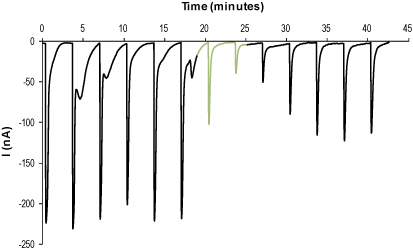Overview
- Wilson, S.P. and Kirshner, N. (1977) J. Neurochem. 28, 687.
- Garcia-Guzman, M. et al. (1995) Eur. J. Neurosci. 7, 647.
- McCann, C.M. et al. (2006) Proc. Natl. Acad. Sci. U.S.A. 103, 5149.
 Alomone Labs α-Bungarotoxin inhibits α7 nicotinic ACh channels heterologously expressed in Xenopus oocytes.Time course of α7 nicotinic ACh channel current recording. Membrane potential was held at -60 mV and constantly perfused with a solution containing 10 mM Ca2+ and 1 μM PNU-120596. 1 μM ACh was applied for 2 seconds every 200 seconds in order to stimulate channel current. 50 nM α-Bungarotoxin (#B-100) was applied (green trace) during the ACh application and inhibited channel current.
Alomone Labs α-Bungarotoxin inhibits α7 nicotinic ACh channels heterologously expressed in Xenopus oocytes.Time course of α7 nicotinic ACh channel current recording. Membrane potential was held at -60 mV and constantly perfused with a solution containing 10 mM Ca2+ and 1 μM PNU-120596. 1 μM ACh was applied for 2 seconds every 200 seconds in order to stimulate channel current. 50 nM α-Bungarotoxin (#B-100) was applied (green trace) during the ACh application and inhibited channel current. Alomone Labs α-Bungarotoxin inhibits muscle nAChR heterologously expressed in Xenopus oocytes.A. Time course of α-Bungarotoxin (#B-100) action on muscle nicotinic ACh channel current (expressing α1/β1/γ/δ nAChRs). Membrane potential was held at -80 mV and oocytes were constantly perfused with a solution containing 0.3 μM PNU-120596. 10 μM ACh was applied every 100 seconds in order to stimulate channel current. 10 nM (red trace) or 50 nM (green trace) α-Bungarotoxin were applied for 4.5 min each during the ACh application and inhibited channel current, as indicated. B. Superimposed traces of muscle nAChR currents in the absence (control) and the presence of 10 nM (red trace) or 50 nM (green trace) α-Bungarotoxin.
Alomone Labs α-Bungarotoxin inhibits muscle nAChR heterologously expressed in Xenopus oocytes.A. Time course of α-Bungarotoxin (#B-100) action on muscle nicotinic ACh channel current (expressing α1/β1/γ/δ nAChRs). Membrane potential was held at -80 mV and oocytes were constantly perfused with a solution containing 0.3 μM PNU-120596. 10 μM ACh was applied every 100 seconds in order to stimulate channel current. 10 nM (red trace) or 50 nM (green trace) α-Bungarotoxin were applied for 4.5 min each during the ACh application and inhibited channel current, as indicated. B. Superimposed traces of muscle nAChR currents in the absence (control) and the presence of 10 nM (red trace) or 50 nM (green trace) α-Bungarotoxin.
- Ohta, M. et al. (1987) FEBS Lett. 222, 79.
- Wilson, P.T. et al. (1988) Mol. Pharmacol. 34, 643.
- Wilson, S.P. and Kirshner, N. (1977) J. Neurochem. 28, 687.
- Garcia-Guzman, M. et al. (1995) Eur. J. Neurosci. 7, 647.
- McCann, C.M. et al. (2006) Proc. Natl. Acad. Sci. U.S.A. 103, 5149.
α-Bungarotoxin isoform A31 is a 74 amino acid peptidyl toxin isolated from the venom of the banded krait snake, Bungarus multicinctus1.
α-Bungarotoxin blocks postsynaptic neuromuscular transmission via competitive inhibition of nicotinic ACh receptors (nAChRs) with an IC50 of 3.5 x 10-10 M, thereby preventing the depolarizing action on postsynaptic membranes and blocking neuromuscular transmission2.
The toxin is selective for α7 receptors (IC50 value of 1.6 nM) and α3/β4 receptors (IC50 value of >3 µM)3,4.
α-Bungarotoxin also binds to and blocks a subset of GABAA receptors (GABAARs) that contain the GABAAR β3 subunit. In particular, α-Bungarotoxin blocks GABAARs that contain interfaces between adjacent β3 subunits5.
α-Bungarotoxin (#B-100) is a highly pure, natural, and biologically active peptide toxin.
Applications
Citations
- Nishioka, T. et al. (2019) Biochem. Biophys. Res. Commun. 509, 514.
- Kiss, T. et al. (2014) PLoS ONE 9, e109538.
- Wen, H. et al. (2013) eLife 2, e01206.

